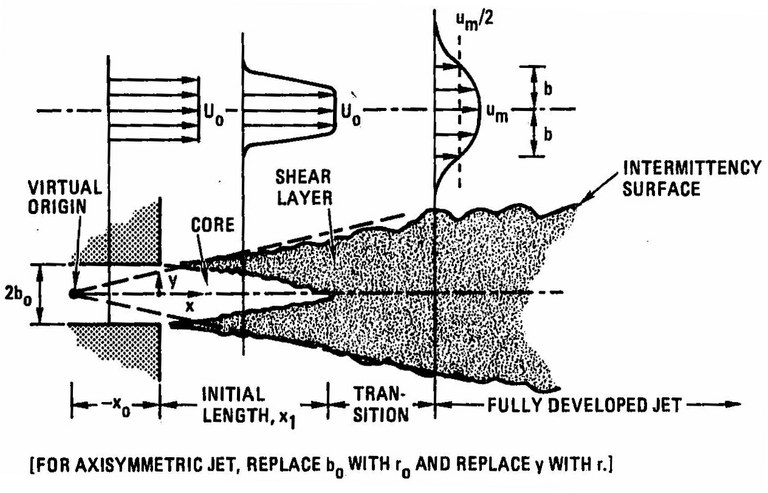
Schematic of simple turbulent jet. From Experimental Comparison of Measured Flow Output of Aquarium Propeller Pumps.

#10: Product Review: Inexpensive Analytical Devices: Hanna Instruments’ Checkers: Alkalinity and Phosphate
By Dana Riddle
In many cases, results from colorimeters are superior to visually judging colored samples. Will an inexpensive device deliver results comparable to an expensive spectrophotometer? Dana tests the Hanna Checkers to find out. Read more…

#9: Feature Article: LED Lighting Tests: Ecoray, Reef Fanatic, and MaxSpect
By Sanjay Joshi, Ph.D.
LED lighting for reef tanks is on its way to becoming a reality, and various designs and configurations are making their way into the market. Read more…

#8: Aquarium Chemistry: The Nitrogen Cycle: New Developments and New Prospects
By Marco Colasanti
So far we have always thought of the nitrogen cycle as a series of linear reactions that conclude in a circle. But is it really a cycle? Important discoveries made in these recent years have drastically revolutionized this concept. In this article, I will try to discuss some of these research studies, with the intention and hope of being able to make this complex topic, understandable. Read more…

#7: Aquarium Fish: A Look at the Gobies
By James W. Fatherree, M.Sc.
After all, many (but certainly not all) are quite hardy and easy to care for, and many are attractive and/or have interesting behaviors. This is especially so when it comes to some of my personal favorites, the shrimp gobies. Read more…

#6: Feature Aquarium: The Aquarium of Craig Bagby
By Craig Bagby
Craig shares his 335 gallon reef system with us this month. His 247 gallon peninsula-style main display – with elegantly minimalistic aquascaping – and frag tank are home to an impressive assortment of vibrant corals and fishes. Read more…

#5: Feature Aquarium: Mike Cao’s Non-Photosynthetic Reef
By Mike Cao
Mike shares his gorgeous 155 gallon non-photosynthetic tank with us this month. Read more…

#4: Feature Aquarium: The 246 Gallon Reef Aquarium of Sonny Harajly
By Sonny Harajly
When designing this aquarium, I had openness and negative space as my top priority. This aesthetically looks better, and allows for a more natural and pleasant display. All too often reefers are quick to stack massive amounts of rock and corals into an aquarium. This in turn gives the display the appearance of a fruit stand, and it is much too cluttered and busy. By allowing the corals a large area to grow, you will be rewarded with natural growth patterns and a better looking display. Read more…

#3: Feature Aquarium: The 240 Gallon Reef Aquarium of Joe Peck
By Joe Peck
If you want to be a successful coral gardner too, my advice is find some friends who have already done it, read as much as you can stand before you start, and take your time to do it “right.” Read more to find out how Joe has done it “right.” Read more…

#2: Feature Article: Bacterial Counts in Reef Aquarium Water: Baseline Values and Modulation by Carbon Dosing, Protein Skimming, and Granular Activated Carbon Filtration
By Ken S. Feldman, Allison A. Place, Sanjay Joshi, Gary White
What are the bacteria populations in the water column of reef tanks, and how does that value compare with bacterial counts in authentic reef water? Does carbon dosing indeed increase water column bacteria populations (i.e., is growth carbon limited)? Does mechanical filtration (protein skimming and/or GAC filtration) actually remove bacteria from the water column, and if so, how much? Ken, Allison, Sanjay, and Gary’s in-depth article puts these questions to the test. Read more…

#1: Feature Article: Experimental Comparison of Measured Flow Output of Aquarium Propeller Pumps
By Michael Sandford, William Straka, Sanjay Joshi
Hobbyists have seen significant advancements in the range of aquarium circulation pumps available over the past decade. While all manufacturers provide a flow rate for the pumps, it is not clear what methods have been used to arrive at the numbers. Further, different manufacturers may use different methods. We have presented a standard method that we hope can be adopted by the manufacturers thus enabling a more accurate and verifiable approach. Read more…









0 Comments